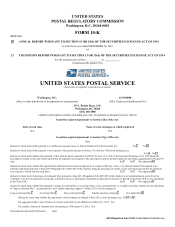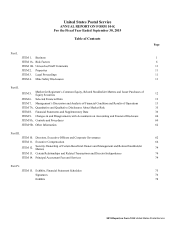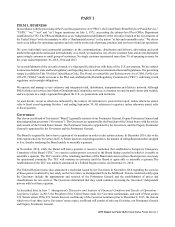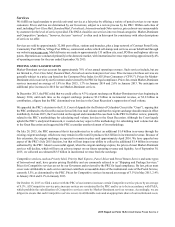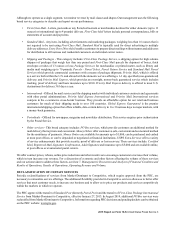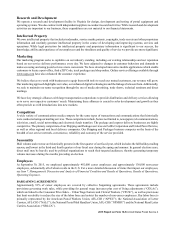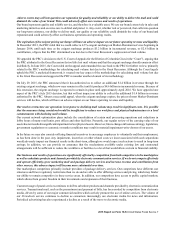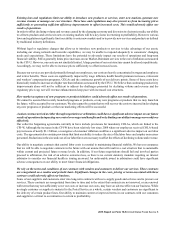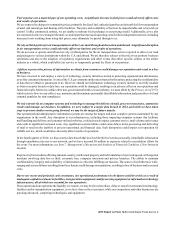US Postal Service 2015 Annual Report Download - page 3
Download and view the complete annual report
Please find page 3 of the 2015 US Postal Service annual report below. You can navigate through the pages in the report by either clicking on the pages listed below, or by using the keyword search tool below to find specific information within the annual report.2015 Report on Form 10-K United States Postal Service 1
PART I
ITEM 1. BUSINESS
In accordance with the provisions of the Postal Reorganization Act (“PRA”), the United States Postal Service (“Postal Service,”
“USPS,” “we,” “our” and “us”) began operations on July 1, 1971, succeeding the cabinet-level Post Office Department
established in 1792. The PRA established us as an “independent establishment of the executive branch of the Government of
the United States” with the mandate to offer a “fundamental service” to the nation “at fair and reasonable rates.” We do not
receive tax dollars for operating expenses and rely solely on the sale of postage, products and services to fund our operations.
We serve individuals and commercial customers in the communications, distribution and delivery, advertising and retail
markets throughout the nation and internationally. As a result, we maintain a very diverse customer base and are not dependent
upon a single customer or small group of customers. No single customer represented more than 3% of operating revenue for
the years ended September 30, 2015, 2014 and 2013.
As an establishment of the executive branch, we align specific objectives with those of the U.S. government. We are subject
to numerous federal, state and local regulatory and reporting laws, as well as environmental laws and regulations. Our governing
statute is codified in Title 39 of the United States Code. The Postal Accountability and Enhancement Act of 2006, Public Law
109-435 (“PAEA”) made revisions to the PRA and established the Postal Regulatory Commission (“PRC”), endowing it with
regulatory and oversight obligations.
We operate and manage a very extensive and integrated retail, distribution, transportation and delivery network. Although
PAEA divides our services into Market-Dominant and Competitive services, we monitor revenue by mail classes and weights,
and we operate as a single segment throughout the U.S., its possessions and territories.
As used herein, except as otherwise indicated by the context, all references to years in this report, unless otherwise stated,
refer to fiscal years beginning October 1 and ending September 30. All references to quarters, unless otherwise stated, refer
to fiscal quarters.
Governance
Our eleven-seat Board of Governors (“Board”) generally consists of our Postmaster General, Deputy Postmaster General and
nine independent governors (“Governors”). The Governors are appointed by the President of the United States with the advice
and consent of the United States Senate. The Postmaster General is appointed by the Governors, and the Deputy Postmaster
General is appointed by the Governors and the Postmaster General.
The Board is required by law to have a quorum of six members in order to take certain actions. In December 2014, due to the
term expiration of one Governor and U.S. Senate inaction on pending nominees, the number of sitting Board members dropped
to five, thereby rendering the Board unable to assemble a quorum.
In November 2014, while the Board still had a quorum, it issued a resolution that established a Temporary Emergency
Committee of the Board (“TEC”) to exercise certain powers reserved to the Board during a period in which it is unable to
assemble a quorum. The TEC consists of the remaining members of the Board and exercises those Board powers necessary
for operational continuity. The TEC will continue in existence until the Board is again able to assemble a quorum. The
establishment of the TEC was publicly announced in a Federal Register notice on December 16, 2014.
The Federal Register notice also announced a resolution issued by the Governors in November 2014 regarding the exercise
of those powers conferred by law solely on the Governors, as distinguished from the full Board. Powers conferred solely upon
the Governors include the appointment and removal of the Postmaster General and the establishment of prices and
classifications for our services. The Governors determined that they could continue exercising the Governors’ independent
powers with less than a quorum.
As described later in Item 7. Management’s Discussion and Analysis of Financial Condition and Results of Operations -
Legislative Update, in 2015, the President of the United States made five Governor nominations, and each of these awaits
U.S. Senate action. If the U.S. Senate does not confirm any of the Governor nominees prior to December 8, 2015, the date on
which two of our three active Governors’ terms expire, our Board will consist of only one Governor, our Postmaster General
and Deputy Postmaster General.

